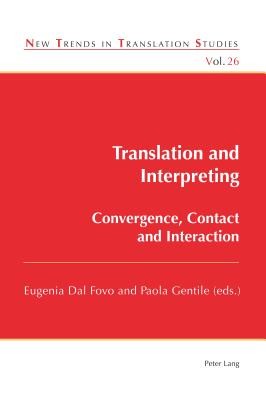
- We will send in 10–14 business days.
- Publisher: Peter Lang Ltd, International Academic Publishers
- Year: 2018
- ISBN-10: 1787077500
- ISBN-13: 9781787077508
- Format: 15.2 x 22.4 x 1.8 cm, softcover
- Language: English
- SAVE -10% with code: EXTRA
Translation and Interpreting; Convergence, Contact and Interaction (e-book) (used book) | bookbook.eu
Reviews
Description
A glance at the current state of the profession reveals a varied scenario in which Translation and Interpreting (T&I) constitute two interlingual processes usually performed by the same person in the same communicative situation or in different situations within the same set of relations and contacts. Although both practices call for somewhat different communicative competences, they are often seen as a single entity in the eyes of the public at large. T&I are thus found in relations of overlap, hybridity and contiguity and can be effected variously in professional practices and translation processes and strategies. Yet, when it comes to research, T&I have long been regarded as two separate fields of study. This book aims to address this gap by providing insights into theoretical and methodological approaches that can help integrate both fields into one and the same discipline. Each of the contributions in this volume offers innovative perspectives on T&I by focusing on topics that cover areas as diverse as training methods, identity perception, use of English as lingua franca, T&I strategies, T&I in specific speech communities, and the socio-professional status of translators and interpreters.
EXTRA 10 % discount with code: EXTRA
The promotion ends in 19d.21:15:08
The discount code is valid when purchasing from 10 €. Discounts do not stack.
- Publisher: Peter Lang Ltd, International Academic Publishers
- Year: 2018
- ISBN-10: 1787077500
- ISBN-13: 9781787077508
- Format: 15.2 x 22.4 x 1.8 cm, softcover
- Language: English English
A glance at the current state of the profession reveals a varied scenario in which Translation and Interpreting (T&I) constitute two interlingual processes usually performed by the same person in the same communicative situation or in different situations within the same set of relations and contacts. Although both practices call for somewhat different communicative competences, they are often seen as a single entity in the eyes of the public at large. T&I are thus found in relations of overlap, hybridity and contiguity and can be effected variously in professional practices and translation processes and strategies. Yet, when it comes to research, T&I have long been regarded as two separate fields of study. This book aims to address this gap by providing insights into theoretical and methodological approaches that can help integrate both fields into one and the same discipline. Each of the contributions in this volume offers innovative perspectives on T&I by focusing on topics that cover areas as diverse as training methods, identity perception, use of English as lingua franca, T&I strategies, T&I in specific speech communities, and the socio-professional status of translators and interpreters.


Reviews